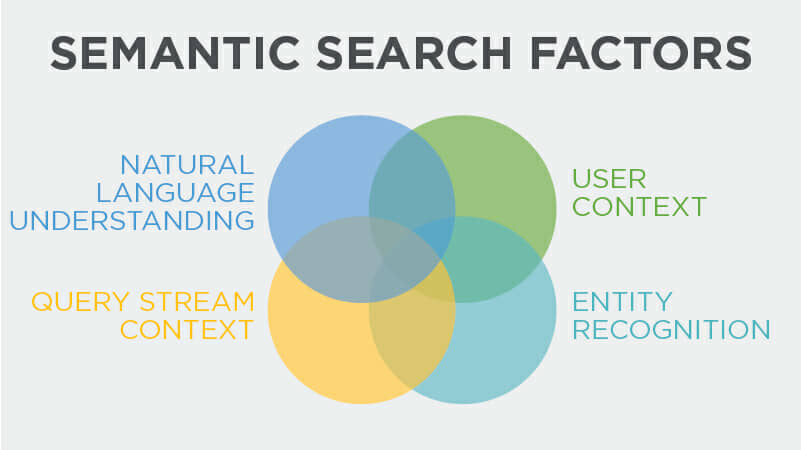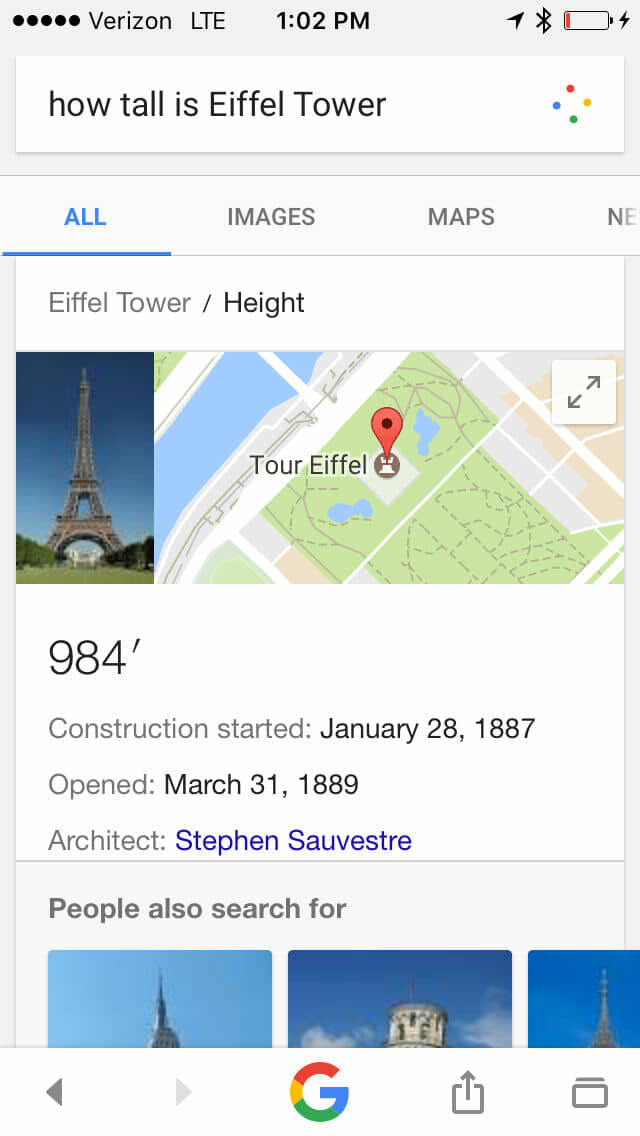
In the world of SEO, there is some confusion about what we mean when we use the term “semantic search.”
This confusion is not surprising—many mistake the phrase semantic search with the concept of structured data (semantic language markup), but this is not the same thing. Others understand the term solely as it applies to the field of linguistics, which is related to meaning in language and logic. To make things easier, let’s start with a clear definition.
What is “Semantic Search”?
Semantic search is a phrase that many people use to refer to the effort by search engines to do a better job in understanding natural language queries. But it also involves a lot more than that, such as the context of the searcher at the moment they enter a query. For example, if they just entered “hotels” as a query, and their prior query was “Paris”, chances are that they want info on “Paris hotels”.
Or, if they have a history of performing lots of searches related to wildlife, and they enter the query “jaguar” chances are greater that they want the animal, and not the car. In addition, search engines did not understand the concept of entities, which is the idea that you can associate properties with peoples, places, events, etc.
In other words, the Empire State building is something that has height, an original architect, a date when it was completed, for which you can see pictures, etc. So now if a user performs an initial query of “Eifel Tower”, and their next query is “how tall is it”, the search engine can respond with the height of the Eifel Tower.

Note that Google alters the query from the way I asked it, “how tall is it”, to “how tall is Eifel Tower” as you can see in the search query box.
These are not things that search engines historically did, and that resulted in users learning over time to tailor their queries to make searches work. These were short phrases that were easier for search engines to process.
The rise of voice search played a big role in changing all that. When people use voice commands to search, they are far more likely to use natural language, and use queries the same way they would when talking to other people, and the search engines are being forced to adapt.
As a result, search engines have doubled down on their efforts to better understand what a search user’s query “means,” or the user’s “intent,” even when they use natural language, so that they may return better, more useful results.
Why should you care about the concept of semantic search? The short answer is that it’s part of a larger shift in how we interact with search engines and therefore impacts how we need to think about our websites and SEO along with it.
About Semantic Search: What it Is, and What It’s Not
Semantic search is about returning meaningful results to a search user’s query, based on the best possible understanding of their actual intent. To do so, search engines need to understand not only the search user’s intent, but also the context of their query.
The search engines have made impressive progress towards achieving their goal of understanding the meaning of users’ queries. Google especially has made huge strides in understanding user intent with its natural language analysis and processing capabilities. It has continued to hone its technology since introducing voice search, to its iPhone mobile app in 2008.
Ultimately, one of Google’s key goals is understanding the world more like people do.
One of the first steps in this direction was the development of the Knowledge Graph, where Google introduced the concept of things not strings.

This is a large-scale database that Google has that includes:
- A massive database of public domain information (such as the capital of Oregon, the number of yards in a mile, the birthday of Margaret Thatcher, etc.).
- The properties that each entity has. For example, humans have names, birthdays, a mother, a father, a place where they live, and may have a job, a spouse, children, etc.). In addition to understanding what these properties are, this information is stored in their database.
Entities and Semantic Search
Key to establishing a digital identity is the concept of “entities.” Entities are simply people, places and things. An understanding of entities, their respective properties and the qualities that define them enables search engines to have a much better understanding of language.
Google stored this data in the Knowledge Graph and uses it in its efforts to improve the quality of its search results.
Entities are at the heart of Google’s oft-quoted transition from “strings to things,” and this has had the effect of making the web, with semantic search, more transparent to both users and the search engines.
The transition from “strings to things” underscores the importance of creating your own semantic entities. In order for an entity to be created, its properties, qualities and attributes need to be indexed, and the connections between them understood.
This is where structured data enter the picture. Structured data can be used to give more information about the elements on a website.
The Role of Structured Data in Semantic Search
Structured data allow search engines to index web pages more quickly and accurately. (For more detailed information about how Google crawls, indexes and ranks web content, you can refer to my article on how Google’s search results work.)
In 2011, Google, Microsoft (Bing) and Yahoo! introduced their collaborative, universal structured data markup project, Schema.org, which both simplifies and standardizes the way structured data is implemented across the web.
Website publishers who choose to mark up the information on their pages using structured data can find useful examples on the Schema.org site.
It’s worthwhile to note that by implementing Schema, online business and site content listings may be given more “shelf space” in the search engine results pages (SERPs) with “rich snippet,” knowledge panel and answer box listings.
Hummingbird and RankBrain
A little more than a year after introducing the Knowledge Graph, Google rolled out Hummingbird in 2013. Hummingbird arguably marks the true beginning of today’s “semantic search.”

Since the initial launch of Hummingbird, Google’s ability to understand linguistic nuances, user intent, contextual content and relational connections has continued to improve.
Some of what search engines try to do is:
- First, take the entire search query into account, rather than just the keywords.
- Second, look at who is carrying out the search, drawing on the user’s search history and search patterns to deliver personalized results.
- Third, factor in how the search itself is being conducted, so variables such as device type, time of day and location are considered.
- Finally, using natural language processing capability to better understand the relationships between queries (as in “conversational search”), as well as between bits of data.
More recently, in 2015, Google introduced RankBrain. Despite its name, RankBrain doesn’t determine Google search rankings. Rather, it serves as part of Google’s overall search algorithm to better understand a user’s search query so it can surface the most relevant results
One of the things that caused RankBrain to attract so much attention when it was announced is that it’s an algorithm that is machine learning-based.
As originally reported by Bloomberg, RankBrain allows Google to make an “educated guess” of what ambiguous words and phrases mean, making it more effective at handling queries it hasn’t encountered before.
Ultimately, the goal is for search engines to continually progress in their understanding of language, so they can better understand user intent and map the correct queries to that intent.
Machine learning will play a major role in continuing improvements in semantic search.
Semantic Search and SEO
So, what does this mean for SEO?
While basic SEO strategies are still important, such as keywords, substantive content, anchor text and backlinks, in the brave new world of semantic search and modern SEO, no single tactic can be pursued to the exclusion of everything else.
SEO can no longer be considered a bolt-on strategy, either. To be effective, it needs to be woven into a company’s digital marketing DNA, and pursued holistically.
Every activity that is part of optimizing a company’s online presence, from its website design to its social network, is crucial to the semantic mapping of its identity, as well as its reputation for credibility and quality content (or lack thereof).
In this sense, the line between SEO and marketing has become blurred.
Google’s mission is to deliver high-quality, high-confidence search results. It needs to “trust” that the website and content it shows the user is relevant and accurate.
So, today’s SEO is more appropriately understood in terms of the three pillars of SEO: authority, relevance and trust.
Backlinks from authoritative sources, author reputation, expert content, citations by influencers and respected individuals, social media status—this is a short list of all the things you should consider in formulating your SEO strategy for today’s digital marketing environment.
These factors don’t need to directly be used as SEO ranking factors for them to be important to your overall SEO strategy.
Google and Bing are going to continue to invest aggressively in increasing their understanding of natural language. The concept of semantic search has forever transformed SEO, creating a more transcendent search landscape where authority, relevance and trust signals reign supreme.
But SEO is not dead, by any means. In fact, this will help drive the maturation of SEO as a modern marketing discipline.
Traditional SEO strategies such as keyword research and link building are still sound in this new world of semantic search. However, the focus on producing great content and great user experiences are more important than ever.
In short, focusing on making your website as useful as it can be has become a major part of SEO, and that’s a very good thing.


Thank you very much for this article on thé SEO
Semantic search is part of the reason why quality over quantity seems to be a better approach when it comes to content. You can now rank for many more keywords than you planned (especially since many queries have never been seen before) as long as you have the best content.
Everybody talks about semantic search in these days, but no one really seems to know what it’s all about. Thank you for sorting this out! I love that these days are here, when usability really matters.
That is awesome haha. Just tried it out typing in “how tall is the brandenburg gate”. If you use google chrome than it even shows the result when typing it in your browser bar. Thanks!
seo now require the text in the search results should also mean more close with the keyword when searching. The purpose for the user search results more diverse!
thank you !
Great post, ERIC ENGE! As a user, I’m very excited for semantic search, e.g., the Space Odyssey example is amazing; it gets you much closer to what you were actually looking for.
With regards to whether or not “keywords are dead”; I don’t think so. Matching search queries verbatim may not be as helpful, but some sense of the search query I think will always be relevant. At least until we’re able to search using something other than language (smell? memory?); that’s certainly the search engine of the far off future. 😉
This will impact more in near future with all those artificial intelligence and machine learning advancements in Google. John Mueller has already hinted that structured data is going to be a part of direct ranking factors. Be topical, be authoritative, be trustworthy and build things conversational for better results in future.